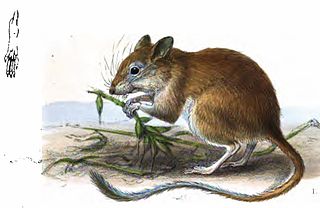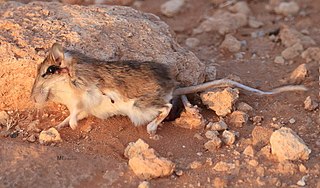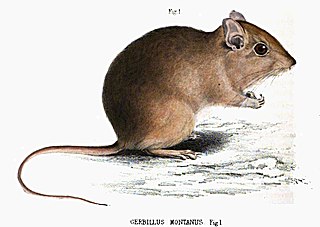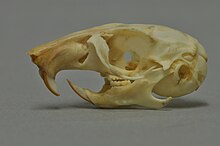
Gerbillinae is one of the subfamilies of the rodent family Muridae and includes the gerbils, jirds, and sand rats. Once known as desert rats, the subfamily includes about 110 species of African, Indian, and Asian rodents, including sand rats and jirds, all of which are adapted to arid habitats. Most are primarily active during the day, making them diurnal, and almost all are omnivorous.
The Berbera gerbil is distributed mainly in Somalia, but its range may extend into Ethiopia and Djibouti. It is endemic to the Ethiopian xeric grasslands and shrublands ecoregion.

The Balochistan gerbil or dwarf gerbil, is distributed mainly from Morocco across north Africa, the Arabian Peninsula, the Middle East, and western Asia. This is a common species with a wide distribution which faces no obvious threats, so the International Union for Conservation of Nature has rated its conservation status as being of "least concern".
Botta's gerbil is a species of gerbil endemic to Sudan and possibly northern Kenya. According to the International Union for Conservation of Nature, it was listed as Least Concern in 1996 until it was listed as Data Deficient in 2004. According to a 2013 book, it is known from a few specimens taken from four or five localities in a small area between the rivers White Nile and Blue Nile; its habitat is fields of vegetables and cereals. Aside from this information, nothing else is known about the species including its population and threats.

The lesser Egyptian gerbil is a small species of rodent in the family Muridae. It is native to North Africa and the Sinai Peninsula, where it lives in sandy habitats. It is a common species, and the International Union for Conservation of Nature has rated its conservation status as being of "least concern".

Cheesman's gerbil is a small rodent in the subfamily Gerbillinae of the family Muridae. It is distributed mainly in Arabian Peninsula to southwestern Iran. It has orange-brown fur, white underparts, large eyes and a very long tail.
Anderson's gerbil is a species of rodent distributed from Tunisia to Israel. Their habitats and diets are similar to other gerbils. The gestation period is 20–22 days and the average litter size is four or five. The IUCN formerly listed the junior synonym Gerbillus allenbyi as vulnerable.
Flower's gerbil is a large gerbil distributed mainly in Egypt, from the eastern fringes of the Nile delta to the Sinai Peninsula, south of El Arish. Less than 250 individuals of this species are thought to persist in the wild, but it is not considered to be at threat, since it is common within its area of habitat and nothing poses a direct threat to it. This species is found in rocky desert, sandy coastal plains, grass valleys, palm tree groves and cultivated areas.

Tarabul's gerbil is a species of small rodent which is found in arid regions of north western Africa.

The North African gerbil is a species of rodent in the family Muridae. It is found in North Africa where its natural habitats are arable land and rocky areas of the Maghreb, and hot Saharan deserts.

The hairy-footed gerbil is a species of rodent found in Angola, Botswana, Mozambique, Namibia, South Africa, and Zimbabwe. Its natural habitats are dry savanna, temperate shrubland, hot deserts, sandy shores, and urban areas. All members of this genus have hair on the soles of their feet, hence the name. They prefer sandy soil or sandy alluvium with grass, scrub or light woodland cover.
The Namib brush-tailed gerbil or Setzer's hairy-footed gerbil is a species of rodent endemic to Angola and Namibia. Its natural habitats are sandy and gravelly plains. It stays in its burrow by day, emerging at night to feed on arthropods, vegetable matter, and seeds.
The dune hairy-footed gerbil, or the Namib dune gerbil is a species of rodent found only in Namibia. Its natural habitat is temperate desert where it lives in loose sand among sand dunes, feeding opportunistically on arthropods, seeds and green vegetation.
Boehm's gerbil is a species of rodent found in Angola, Burundi, Democratic Republic of the Congo, Kenya, Malawi, Mozambique, Rwanda, Tanzania, Uganda, and Zambia. Its natural habitats are dry savanna, moist savanna, and arable land. This is a common species with a wide distribution which faces no obvious threats, so in 2004 the International Union for Conservation of Nature rated its conservation status as being of "least concern".

The highveld gerbil is a species of rodent found in Angola, Botswana, Lesotho, Namibia, South Africa, Eswatini, Zambia, and Zimbabwe. Its natural habitats are dry savanna, temperate shrubland, subtropical or tropical dry shrubland, temperate grassland, and temperate desert. This is a common species with a wide range and the International Union for Conservation of Nature has rated it as being of "least concern" as of 2008.
The Guinean gerbil is a species of rodent found in Burkina Faso, Gambia, Ghana, Guinea, Guinea-Bissau, Ivory Coast, Mali, Senegal, Sierra Leone, and possibly Liberia. Its natural habitats are subtropical or tropical dry forests, dry savanna, rocky areas and arable land, but it is mostly found in areas laterite or clay soils, and with variable amounts of vegetation and dense scrub. This species is described as common and has a stable population and a wide distribution, so the International Union for Conservation of Nature has rated its conservation status as being of "least concern".

The Asian garden dormouse or large-eared garden dormouse, is a species of rodent in the family Gliridae. It is found in Egypt, Iraq, Israel, Jordan, Lebanon, Libya, Saudi Arabia, Syria and Turkey. Its natural habitats are temperate forests, subtropical or tropical dry shrubland, Mediterranean-type shrubby vegetation, rocky areas and gardens.

Whitaker's shrew is a species of mammal in the family Soricidae. It is found in Western Sahara, Algeria, Morocco, Tunisia. Its natural habitats are subtropical or tropical dry shrubland, rocky and sandy coasts. It is a fairly common species and the International Union for Conservation of Nature has rated its conservation status as being of "least concern".












